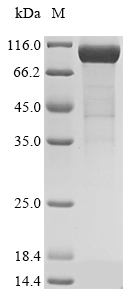Complement factor I (CFI) is an 88 kDa glycoprotein primarily synthesized by the liver [1]. It is a serine protease that plays a crucial role in regulating the complement system activation [2]. CFI functions as a complement inhibitor, deactivating C3b and C4 to prevent the formation of C3 convertase, thereby negatively regulating the alternative and classical complement pathways [3]. CFI achieves this by degrading C4b and C3b in the presence of cofactors such as C4b-binding protein (C4BP), complement factor H (CFH), membrane cofactor protein (MCP), and complement receptor 1 (CR1) [4]. Mutations in the CFI gene have been associated with atypical hemolytic uremic syndrome (aHUS), leading to altered secretion or function of CFI [5]. Additionally, CFI has been implicated in age-related macular degeneration (AMD), with rare variants within CFI being reported in advanced AMD patients [6].
Furthermore, genetic abnormalities in CFI, along with other complement regulatory proteins, have been linked to aHUS, with more than 120 mutations in CFH, CFI, and MCP reported in aHUS patients [7]. These genetic variants in the complement system, including CFI, account for a significant proportion of aHUS cases [8]. Moreover, CFI, along with other complement regulators, has been found to have a relative role in both sporadic and familial aHUS, impacting the clinical phenotype of the disease [7].
References:
[1] A. Shields, A. Pagnamenta, P. Aj, J. Taylor, H. Allroggen, S. Patelet al., "Classical and non-classical presentations of complement factor i deficiency: two contrasting cases diagnosed via genetic and genomic methods", Frontiers in Immunology, vol. 10, 2019. https://doi.org/10.3389/fimmu.2019.01150
[2] Y. Liu, Z. Lv, T. Xiao, X. Zhang, C. Ding, B. Qinet al., "Functional and expressional analyses reveal the distinct role of complement factor i in regulating complement system activation during gcrv infection in ctenopharyngodon idella", International Journal of Molecular Sciences, vol. 23, no. 19, p. 11369, 2022. https://doi.org/10.3390/ijms231911369
[3] E. Levit, J. Leon, & M. Lincoln, "Pearls & oy-sters: homozygous complement factor i deficiency presenting as fulminant relapsing complement-mediated cns vasculitis", Neurology, vol. 101, no. 2, 2023. https://doi.org/10.1212/wnl.0000000000207079
[4] X. Cai, W. Qiu, M. Qian, S. Feng, C. Peng, J. Zhanget al., "A candidate prognostic biomarker complement factor i promotes malignant progression in glioma", Frontiers in Cell and Developmental Biology, vol. 8, 2021. https://doi.org/10.3389/fcell.2020.615970
[5] S. Nilsson, N. Kalchishkova, L. Trouw, V. Frémeaux‐Bacchi, B. Villoutreix, & A. Blom, "Mutations in complement factor i as found in atypical hemolytic uremic syndrome lead to either altered secretion or altered function of factor i", European Journal of Immunology, vol. 40, no. 1, p. 172-185, 2009. https://doi.org/10.1002/eji.200939280
[6] D. Qian, M. Kan, X. Weng, H. Yugeng, C. Zhou, Y. Gen-longet al., "Common variant rs10033900 near the complement factor i gene is associated with age-related macular degeneration risk in han chinese population", European Journal of Human Genetics, vol. 22, no. 12, p. 1417-1419, 2014. https://doi.org/10.1038/ejhg.2014.37
[7] M. Noris, J. Caprioli, E. Bresin, C. Mossali, G. Pianetti, S. Gambaet al., "Relative role of genetic complement abnormalities in sporadic and familial ahus and their impact on clinical phenotype", Clinical Journal of the American Society of Nephrology, vol. 5, no. 10, p. 1844-1859, 2010. https://doi.org/10.2215/cjn.02210310
[8] M. Geerlings, E. Volokhina, N. Kar, M. Pauper, C. Hoyng, L. Heuvelet al., "Genotype‐phenotype correlations of low‐frequency variants in the complement system in renal disease and age‐related macular degeneration", Clinical Genetics, vol. 94, no. 3-4, p. 330-338, 2018. https://doi.org/10.1111/cge.13392






